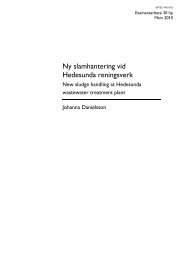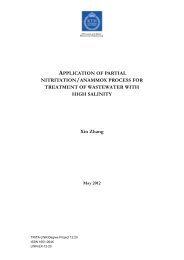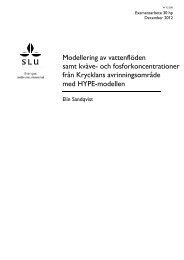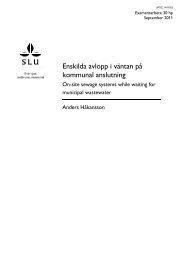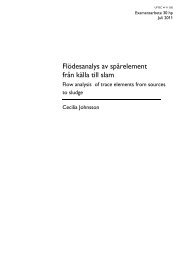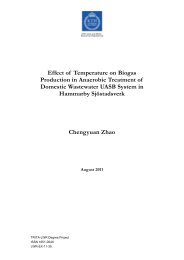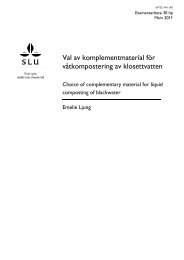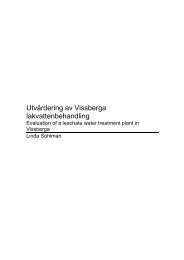Peter Malmros
Peter Malmros
Peter Malmros
You also want an ePaper? Increase the reach of your titles
YUMPU automatically turns print PDFs into web optimized ePapers that Google loves.
ABSTRACT<br />
Biogas potential of the reject fraction from the biogas plant<br />
Kungsängens gård<br />
<strong>Peter</strong> <strong>Malmros</strong><br />
The biogas production in Sweden in 2009 was 1,4 TWh and 22 % of the biogas was<br />
produced in co-digestion plants. Since 2005 it is prohibited to deposit organic waste and<br />
this has resulted in an increased biogas production from this type of waste materials in<br />
recent years. The total biogas potential in Sweden is approximately 15 TWh and 70 %<br />
of that comes from agriculture wastes. Sewage sludge, waste from food industry and<br />
food waste accounts for the rest. It is also these three commodity groups that have the<br />
greatest profitability with today's technology. Among these groups, food waste have the<br />
largest remaining biogas potential. The problem with food waste is that it often contains<br />
impurities that must be sorted out in order to avoid operational problems. The out<br />
sorting process often causes problems and typically organic material is lost in the reject<br />
fraction.<br />
The biogas plant Kungsängens gård is a co-digestion plant that produces biogas from<br />
different types of organic residues. In 2009 about 7 536 tons of material were treated, of<br />
which 58 % was food waste. Of the incoming material 938 tons were sorted out as<br />
reject. In 2011 the amount of incoming material is expected to increase. In addition, the<br />
proportion of food waste is expected to increase to 90 %, which will result in even<br />
larger amounts of reject. The purpose of this study was to perform analysis and batch<br />
digestion experiments to determine the chemical composition and methane potential of<br />
the reject from the biogas plant Kungsängens gård. An investigation was also made to<br />
examine methods and technologies that potentially could be used to produce biogas<br />
from the reject.<br />
The results from the batch digestion experiments showed that the methane potential of<br />
the different reject fractions was high and it can be compared with what might be<br />
expected of source separated food waste. If the reject that was produced in 2010 would<br />
be used for biogas production, this methane potential is equal to 10 % of the total<br />
production of biogas at Kungsängens gård in 2010. The investigation shows that dry<br />
fermentation with a batch system is the only technology that potentially could produce<br />
biogas from the reject in its existing form. There are no dry fermentation plants in<br />
Sweden and therefore the level of knowledge is relatively low. Because of that it is hard<br />
to estimate the profitability and efficiency of dry fermentation plants.<br />
Keywords: biogas, biogas potential, food waste, reject handling, dry fermentation.<br />
Department of Microbiology, The Swedish University of Agriculture Sciences,<br />
Genetikcentrum, Genetikvägen 5, SE- 750 07 Uppsala<br />
ISSN 1401-5765<br />
ii



